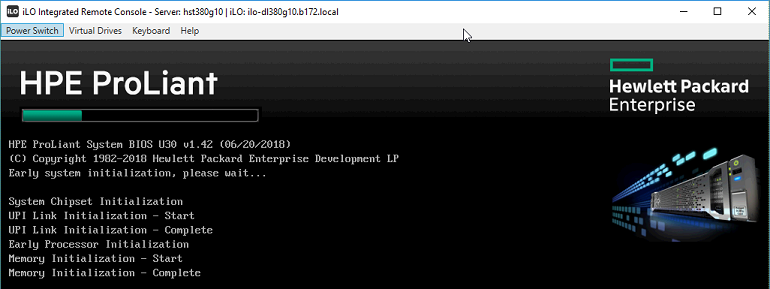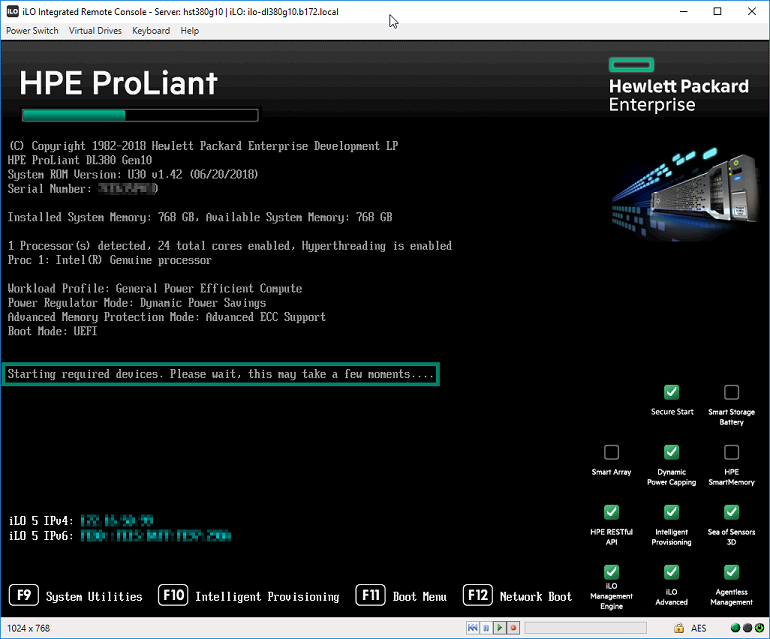
Master the Redfish Server States to improve your monitoring and management applications
August 6, 2018Updated November, 2024
Introduction
Server management and monitoring often require the knowledge of the state of the managed servers (On, Off....). The Redfish® standard defines the PowerState property with Off On as possible values. However, when the system is in the On state, you may want to know in which sub-state the server is: Pre-OS Tasks (POST), Operating System (OS) running. You may want to know, too, if the storage controllers or network cards have been discovered properly.
This blog presents the PostState property available in the Oem.Hpe extension of the ComputerSystem Redfish sub-tree of HPE servers (Gen9, Gen10 and Gen11). It presents as well the DeviceDiscoveryCompleteproperty, part of the same OEM extension and extremely important when you want to configure PLDM for RDE devices.
In the last paragraph you will find a description of the BootProgress{}
object and its properties providing valuable information related to the OS boot progress.
HPE PostState
As mentioned in the HPE iLO 4 API Reference documents, the PostState property can have the following values: Null, Unknown, Reset, PowerOff, InPost, InPostDiscoveryComplete and FinishedPost.
Since the first four values have a straight forward meaning, I'll focus only focus on the other ones.
The InPost value means that the server is still performing the Pre-OS Tasks (tests and hardware discovery). With a graphical console opened, when a server is in this state you can see a green progress bar:


InPostDiscoveryStart follows the InPost state and then, InPostDiscoveryComplete. For the purpose of this blog, I'll assume that it corresponds to the state in which UEFI is loaded and running:

Note that when an UEFI executable is running (i.e. UEFI Shell, grubx64.efi...) the server stays in the InPostDiscoveryComplete state.
The last possible value for the PostState key is FinishedPost. In this state, the server is either booting an installed OS or has completely finished its boot process.
PostState use cases
The first obvious use case for probing the PostState of a server or a set of servers is in a monitoring application. Combined with the health status of the different components of the server, you will be able to draw dashboards or create reports.
In a server management and configuration context, several properties can only be modified when the server is in a particular state. For example, the boot order can only be modified in the Off or in the FinishedPost states.
In the following screenshot I used iLOrest to change the next boot entry of a server being in the InPostDiscoveryComplete state. In this case, the iLO returns a [400] error code with an explicit message.

In a Bios and/or storage controller configuration process, the PostState property plays a crucial role. As explained in
Setting Bios and Storage Controller Properties with Redfishthis process is performed in two phases: 1 - parameter setup into a Redfish pending area. 2 - Reset / Cold Boot of the server to trigger a POST during which the new settings will be verified and transferred, if validated, from the pending area into the active area.
When the modifications are not validated during the second phase a message explaining the problem can be retrieved once the server is in the InPostDiscoveryComplete or FinishedPost states.
Hence, as a best practice, it is wise to pool the managed nodes and check for possible error messages when they are in one of those states (InPost or InPostDiscoveryComplete).
How do I retrieve the Server State
The easiest way to obtain the PostState of a server is to issue the serverstate macro command of the iLOrest utility. ILOrest automatically detects the generation of the server (Gen9, Gen10...) and fetches the PostState value from the right Redfish URI.
The Open Source version of iLOrest contains the source of this ServerState macro command in Python. Feel free to consult it.

PostState with iLOrestIf you decide to create your own Redfish client, you will have to adapt your code to the potential Redfish data model changes between the different generations of servers or iLOs.
As a concrete example, in an HPE rack mount server the PostState property has moved from /redfish/v1/Systems/1/Oem/Hp in Gen9 models to /redfish/v1/Systems/1/Oem/Hpe in Gen10s and later.
The DeviceDiscoveryComplete object
In addition to the PowerState and PostState properties, the DeviceDiscoveryComplete{} object returns the states of the Agentless Management Service
(AMS), SmartArrays (if any) and a third generic discovery state for all devices.
It may happen during startup that a system returns InPostDiscoveryComplete while not all of its devices have been discovered, like PLDM for RDE capable devices.
The following script polls every other second the PostState and the DeviceDiscoveryComplete properties using the cURL Redfish client:
let i=1 while [ 1 ] ; do echo $i $CURL --silent --insecure -u ${ILO_USER}:${ILO_PASSWD} \ --request GET \ -H "OData-Version: 4.0" \ https://${ILO_IP}/redfish/v1/Systems/1/ \ | jq -r '.Oem.Hpe.PostState, .Oem.Hpe.DeviceDiscoveryComplete' sleep 2 let i++ echo done
The following picture shows three iterations of the above script during the start of a server. In iteration 55 the server is InPost while the SmartArray is in a Cached state meaning that it will answer queries with cached data.
Two seconds later the next iteration returns the InPostDiscoveryComplete state and shows the SmartArray in Busy mode which means that it will return an error if queried during this state.
In iteration 62 we are still in InPostDiscoveryComplete but both DeviceDiscovery and SmartArrayDiscovery have reached their final Complete state. Hence the the corresponding devices can be queried safely.

DeviceDiscoveryComplete{} objectIf iLOrest is your preferred Redfish client tool, the above script looks like:
let i=1 u="ilo-user" p="ilo-password" ilo_ip="ilo-ip" ilorest login $ilo_ip -u $u -p $p while [ 1 ] ; do echo $i ilorest get Oem/Hpe/PostState Oem/Hpe/DeviceDiscoveryComplete \ --select ComputerSystem. --refresh --json sleep 2 let i++ echo done
The BootProgress object
Starting with HPE iLO 6 version 1.63 and later, the BootProgress{}
object is populated in the main
ComputerSystem member, under /redfish/v1/Systems/1, when the BIOS/ROM is modern enough.
In previous versions, this object was populated
only in Data Processing Units (DPUs) and SmartNIC members,
under /redfish/v1/Systems/{item} with item > 1.
The Pensando device is an example of such DPU with the BootProgress{} populated.
Note: HPE iLO 5 only populates this object for members under
/redfish/v1/Systems/{item}withitem > 1.
The LastState property of the BootProgress{}
object contains
interesting values like:
SetupEntered: The system has entered the setup utilityOSRunning: The operating system is running
You can monitor the BootProgress.LastState property with the following iLOrest script:
u="ilo-user" p="ilo-password" ip="ilo-ip" ilorest login $ip -u $u -p $p while [ 1 ] ; do ilorest get BootProgress/LastState --select ComputerSystem. --refresh --json sleep 3 ; echo done ilorest logout
Conclusion
The global Power state of HPE iLO based servers can be retrieved
from the standard PowerStateproperty. However, this property may
not be sufficient in all your management tasks.
In iLO 5 and later, additional sub states can be obtained from the OEM PostState
propertyand the DeviceDiscoveryComplete{}
resource.
HPE iLO 6 and later feature the BootProgress{}
objectthat provides a different view of the server states. Depending On
your needs, choose the most suitable resource.
HPE provides as well a rich Redfish ecosystem including the free iLOrest tool, its Open Source version and a Python library. PowerShell developers have the possibility to use a set of specific Redfish Cmdlets required to run the GitHub ProLiant SDK.
Don't forget to check out some of my other blog posts on the HPE Developer portal to learn more about Redfish tips and tricks.
Related

Benefits of the Platform Level Data Model for Firmware Update Standard
Jun 7, 2022
Build your own iLO Redfish simulator
Jun 11, 2021
Discover the power of data center monitoring using Redfish telemetry and cloud-native tooling: Part 2 - Streaming
Dec 1, 2023
Discover the power of data center monitoring using Redfish telemetry and cloud-native tooling
Oct 5, 2023
How to change the factory generated iLO Administrator password
Mar 29, 2018